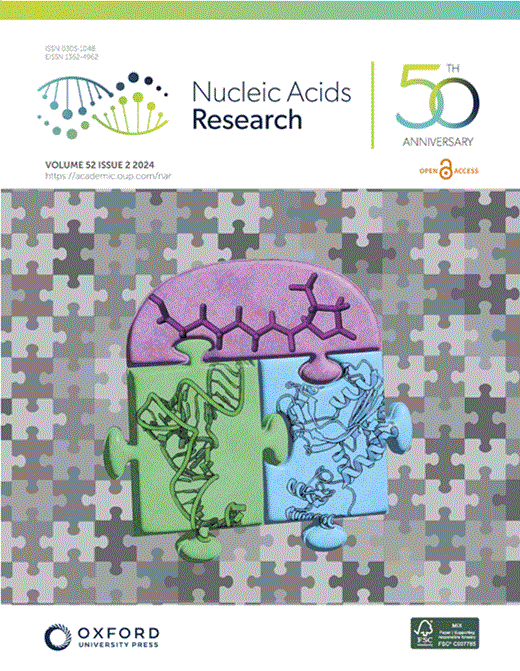G-quadruplex topologies determine the functional outcome of guanine-rich bioactive oligonucleotides
IF 16.6
2区 生物学
Q1 BIOCHEMISTRY & MOLECULAR BIOLOGY
引用次数: 0
Abstract
Guanine-rich nucleic acid sequences can exert sequence- and/or structure-specific activities to influence biological and pathobiological cellular processes. As such, it has been reported that different G-rich oligonucleotides (both DNA and RNA) can have cytotoxic as well as cytoprotective effects on the cells. However, the mechanisms of such a biological outcome are unclear. Here, we report that G-rich DNA oligonucleotides (ODNs) that can form four-stranded secondary structures called G-quadruplexes (G4s) have a topology-dependent biological outcome. Using different biochemical, biophysical, and cellular approaches, we demonstrate that only the parallel topology G4-forming ODNs can repress eukaryotic messenger RNA (mRNA) translation by directly interacting with eukaryotic translation initiation protein 1 (EIF4G1), while the anti-parallel topology G4s do not have inhibitory effect on mRNA translation. These results directly connect the G4 topological differences within ODNs to differential functional impacts in mRNA translation intrans. Our study provides the foundation for the rational design of G-rich oligonucleotides for a desired therapeutic outcome.g -四重体拓扑结构决定了富鸟嘌呤生物活性寡核苷酸的功能结局
富含鸟嘌呤的核酸序列可以发挥序列和/或结构特异性活性,影响生物和病理细胞过程。因此,据报道,不同的富含g的寡核苷酸(DNA和RNA)对细胞具有细胞毒性和细胞保护作用。然而,这种生物学结果的机制尚不清楚。在这里,我们报告了富含g的DNA寡核苷酸(odn)可以形成四链二级结构,称为g -四plex (G4s),具有拓扑依赖性的生物学结果。利用不同的生化、生物物理和细胞方法,我们证明了只有形成g4的平行拓扑的odn可以通过直接与真核翻译起始蛋白1 (EIF4G1)相互作用来抑制真核信使RNA (mRNA)的翻译,而反平行拓扑的g4对mRNA的翻译没有抑制作用。这些结果直接将odn中G4的拓扑差异与mRNA翻译内含子的不同功能影响联系起来。我们的研究为合理设计富g寡核苷酸以获得理想的治疗效果提供了基础。
本文章由计算机程序翻译,如有差异,请以英文原文为准。
求助全文
约1分钟内获得全文
求助全文
来源期刊

Nucleic Acids Research
生物-生化与分子生物学
CiteScore
27.10
自引率
4.70%
发文量
1057
审稿时长
2 months
期刊介绍:
Nucleic Acids Research (NAR) is a scientific journal that publishes research on various aspects of nucleic acids and proteins involved in nucleic acid metabolism and interactions. It covers areas such as chemistry and synthetic biology, computational biology, gene regulation, chromatin and epigenetics, genome integrity, repair and replication, genomics, molecular biology, nucleic acid enzymes, RNA, and structural biology. The journal also includes a Survey and Summary section for brief reviews. Additionally, each year, the first issue is dedicated to biological databases, and an issue in July focuses on web-based software resources for the biological community. Nucleic Acids Research is indexed by several services including Abstracts on Hygiene and Communicable Diseases, Animal Breeding Abstracts, Agricultural Engineering Abstracts, Agbiotech News and Information, BIOSIS Previews, CAB Abstracts, and EMBASE.
 求助内容:
求助内容: 应助结果提醒方式:
应助结果提醒方式:


